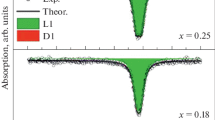Abstract
Dehydroxylation of muscovite in the form of small lamellae at 923 <T <1173 K was studied by Electron Spin Resonance (ESR) on Fe3+. The kinetics of the process has been established to be described by the model of continuous nucleation on the large surface planes of the small plates. Determined by experimental data the rate constant of the process k is shown to be that of dehydroxylation itself. The activation energy obtained by data at T<1100 K is 97.5 KJ·mol−1. The nonlinear dependence of ln(k) on 1/T is explained by the theory of transitions induced by the fluctuative preparation of a potential barrier as a result of thermal oscillations of ions in the lattice. At high temperatures the potential curve of the hydroxyl's proton is transformed so that it can overcome the barrier from one potential well to the other (from one hydroxyl site to the adjacent one). Such transformations of the curve can be caused by the oscillations of large structural clusters (∼1·10−22 kg) with the frequency ∼4.5·1012 s−1.
Similar content being viewed by others
Author information
Authors and Affiliations
Additional information
Received: 3 August 1995 / Accepted: 13 April 1997
Rights and permissions
About this article
Cite this article
Kalinichenko, E., Litovchenko, A., Kalinichenko, A. et al. The study of the kinetics and the mechanism of dehydroxylation in muscovite by ESR on Fe3+ . Phys Chem Min 24, 520–527 (1997). https://doi.org/10.1007/s002690050067
Issue Date:
DOI: https://doi.org/10.1007/s002690050067



